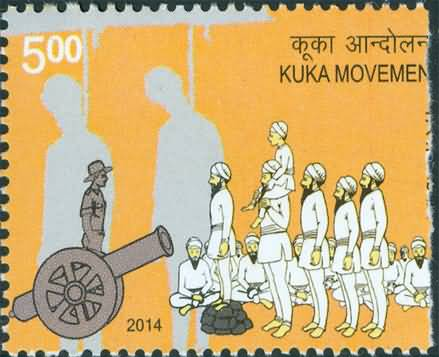Kuka Movement

Technical Data
| Date of Issue | December 24, 2014 |
|---|---|
| Denomination | Rs. 5 |
| Quantity | 600,000 |
| Perforation | 13¾ |
| Printer | Security Printing Press, Hyderabad |
| Printing Process | Wet Offset |
| Watermark | No Watermark |
| Colors | Multicolor |
| Credit (Designed By) | Smt. Alka Sharma |
| Catalog Codes |
Michel IN 2856 Yvert et Tellier IN 2599 Stanley Gibbons IN 3030 |
| Themes | Uprising | Weapons |
Background: Resistance After the First War of Independence
Following the First War of Independence in 1857, several localized uprisings emerged across India. Though scattered, these revolts reflected the widespread dissatisfaction and simmering resentment among Indians against British rule. Among these resistance movements, the Kuka Movement in Punjab was one of the earliest and most powerful expressions of political awakening.
Origins of the Namdhari (Kuka) Movement
The Namdhari Movement, popularly known as the Kuka Movement, marked the first major people’s reaction in Punjab to British occupation after 1849. The Namdharis were called “Kukas” because of their distinctive method of reciting Gurbani in a high-pitched voice known as “kook”.
On 12 April 1857, Satguru Ram Singh, the son of a humble carpenter, founded the Namdhari Sect at Bhaini Sahib, near Ludhiana. Born on 3 February 1816, he rose from ordinary circumstances to become a spiritual reformer and eventually, the visionary leader of a bold anti-colonial movement.
Vision of Satguru Ram Singh
Satguru Ram Singh urged his followers to resist British authority through:
- Boycott of British goods and services
- Refusal to accept British laws and institutions
- Promotion of Swadeshi ideals
- Strict adoption of simple hand-spun white attire
He organized his followers with military precision—appointing governors and deputies in various districts and inspiring young men through disciplined training. Over time, he grew into a secular and political leader, holding informal courts and travelling with armed horsemen.
Awakening of National Consciousness
The Kuka Movement awakened the people of Punjab to their bondage, serfdom, and the urgency of self-respect. The movement’s ideals mirrored the later principles of civil disobedience:
- Boycott of British educational institutions
- Rejection of British legal systems
- Promotion of indigenous practices
- Non-cooperation with colonial governance
Within a short period, the Kukas expanded across Punjab, becoming a powerful symbol of early national consciousness.
The 1872 Malerkotla Incident and Brutal Suppression
Tension between the Kukas and the British escalated steadily. The conflict finally erupted in 1871 and reached its climax with the Kuka raid on Malerkotla on 15 January 1872.
The aftermath was marked by one of the most brutal punishments in colonial history:
- Scores of Kuka prisoners were blown apart by cannons
- Satguru Ram Singh was arrested and deported to Rangoon, where he remained for the rest of his life
This harsh repression, meant to crush the movement, instead etched the Kukas’ courage into the annals of India’s freedom struggle.
Continued Influence and Role in India’s Freedom Movement
Even after the crackdown, the Namdhari spirit remained alive. The community continued its intellectual and social efforts:
- 1920 – Launched the publication Satjug
- 1922 – Started the daily newspaper Kuka
When Mahatma Gandhi launched the Non-Cooperation Movement, the Kukas enthusiastically joined hands, aligning naturally with the principles of Swadeshi and civil disobedience they had practiced for decades.
Commemorative Stamp
To honor the legacy of this pioneering resistance movement, a commemorative postage stamp on the Kuka Movement was issued, celebrating its historic role in igniting the spirit of freedom in Punjab and India.

Leave a Comment
You must be logged in to post a comment.